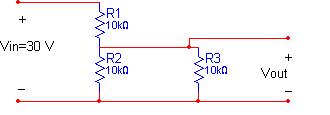hatela
Newbie level 5
Dear Friends,
I have a problem concerning voltage divider. As you all can see in the picture,

all resistors are 10K. Vin=30volts and o/p is across r3.
Now when I do simple KVL I get the volt drop across R1 as 20Volts and across R3 and R2 as 10 Volts each. So is tyhe o/p voltage 10 volts.. ????
And if I find using thevenin theorem, I get the vth as around 10 volts. Rth as 3.33K ohms and the short circuit current as 3mA. So according to the thevenin equivalent circuit comprising of the 10 volt battery and 3.33Kohm resistoe in series with the 10K ohm load the load voltage comes to around 5 Volts. (approx=4.5 volts).
Can anyone please tell me what is my mistake or where did I go wrong.....
Added after 34 minutes:
oops... sorry, the o/pvoltage using thevenins comes to 7.5 volts....
I have a problem concerning voltage divider. As you all can see in the picture,

all resistors are 10K. Vin=30volts and o/p is across r3.
Now when I do simple KVL I get the volt drop across R1 as 20Volts and across R3 and R2 as 10 Volts each. So is tyhe o/p voltage 10 volts.. ????
And if I find using thevenin theorem, I get the vth as around 10 volts. Rth as 3.33K ohms and the short circuit current as 3mA. So according to the thevenin equivalent circuit comprising of the 10 volt battery and 3.33Kohm resistoe in series with the 10K ohm load the load voltage comes to around 5 Volts. (approx=4.5 volts).
Can anyone please tell me what is my mistake or where did I go wrong.....
Added after 34 minutes:
oops... sorry, the o/pvoltage using thevenins comes to 7.5 volts....